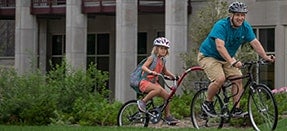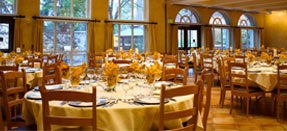The best defense against a fire is to prevent one from starting. This can be done by maintaining good housekeeping and not allowing combustible (paper, cardboard, sawdust) and flammable (chemicals, fuel) to accumulate.
If you see smoke or fire in the building sound the alarm and evacuate immediately. Do not try to find the source to put out the fire. In all fire incidents, you should:
-
Make sure you always have a safe exit route away from the fire
-
Notify co-workers by shouting out that there is a fire
-
Notify emergency services by pulling the fire alarm, dialing 911 and dialing 13000 (Campus Safety)
-
Never assume a false alarm and evacuate the building every time the alarm sounds.
Fire Extinguishers
In order to use a fire extinguisher, you must first be trained on its use. If you are present when a fire starts and feel comfortable putting out a small fire, it is acceptable to use a fire extinguisher. The Occupational Safety & Health Administration (OSHA) requires employees to be familiar with the use of a fire extinguisher. If you have not received Fire Extinguisher training you should never attempt to use one. It is not just a matter of picking the fire extinguisher, pulling the pin, and squeezing. The training provides instruction on (1) the four types of fires, (2) the type of extinguisher to use for the applicable fire, and (3) how to operate a fire extinguisher. Contact your supervisor about proper training. If you see that a fire extinguisher is missing, damaged, or has an out-of-date inspection sticker call Facilities Management at 1-4511.
Fire Drills
Building fire drills take place to confirm that occupants respond appropriately to the fire alarm by evacuating the building. You should always be aware of egress routes in any building you are in. Evacuate the building if you hear the fire alarm. If time permits, turn off any gas or electrical systems. Even if it’s a drill, your responsibility is to evacuate in a timely manner.
Hot Work
Every year fires destroy buildings costing millions of dollars. The insurance industry reports that a high percentage of these fires are caused by hot work. What is hot work? Hot work is defined as any temporary operation, involving open flames or producing heat and/or sparks. Examples of hot work include torch cutting, welding, soldering, brazing, and grinding. All hot work requires a Hot Work Permit.
Performing hot work without the authorization of a Hot Work Permit is not only a violation of DU policy but could result in a catastrophic event. Please contact the Director of EH&S at 303-871-7501, if you have any questions about this matter.
-
Requirements for DU Staff Performing or Supervising Hot Work
All DU staff performing Hot Work or supervising Hot Work must have a certificate of training obtained through FM Global at http://training.fmglobal.com. First-time users must request a password referencing DU's index 72522.95.
Once training has been completed successfully the certificate should be printed with copies given to the employee's supervisor and to the EHS Director, Mary Reed Building room 418. Certificates are located under (My Report-Controls-View Certificate) on the FM Global website.
-
Requirements for Contractors at DU
To obtain training passwords, contractors must submit a list of employees, their e-mail addresses and their company's name plus a reference to DU index 72522.95 to Paul Mullin. Once passwords are issued, the training can be found at http://training.fmglobal.com. Certificates for contractors should also be sent to the EHS Director, Mary Reed Building room 418. Certificates are located under (My Report-Controls-View Certificate) on the FM Global website.
-
Fire-Watch Requirements
All hot work requires a fire-watch for sixty (60) minutes following the completion of work. After the initial one-hour fire watch, an additional three (3) hours is required. This can be accomplished by smoke detectors or sprinkler systems linked to Campus Safety. Upon completion of the initial fire-watch, the permit should be signed by the individual doing the fire watch and sent to the EHS Director.
Buildings with disabled detection or suppression systems, systems that are not linked to Campus Safety or without these systems altogether must be monitored in person for three (3) hours following the initial fire-watch. This can be accomplished by the individual doing the initial one-hour fire-watch or, if on campus, through Campus Safety 303-871-2334.
During the initial 60-minute fire-watch Campus Safety should be called to the area to show where the hot work was performed. Campus Safety will perform periodic checks during the three hours following the initial 60-minute fire watch. The officer performing these checks will sign off on the permit and send it to the EHS Director.







